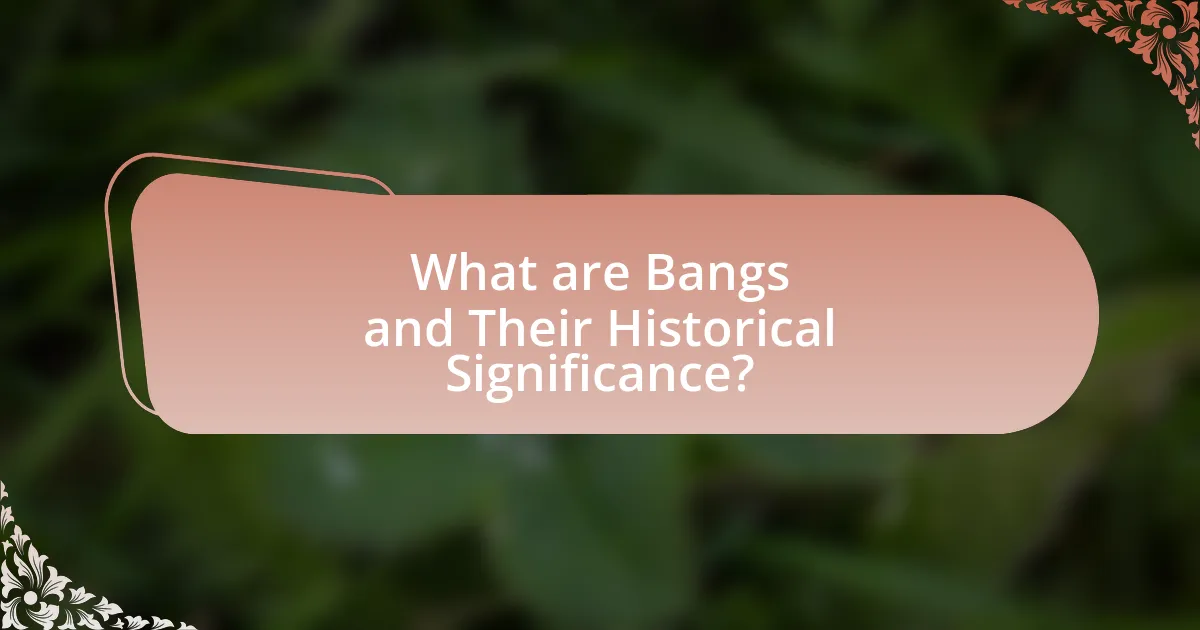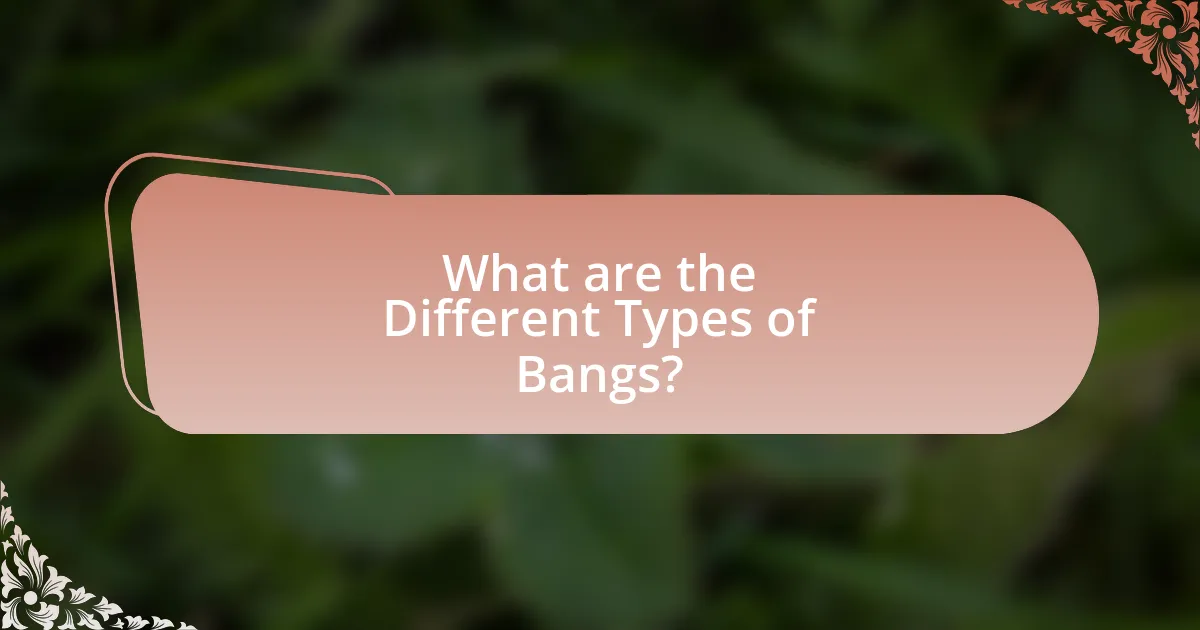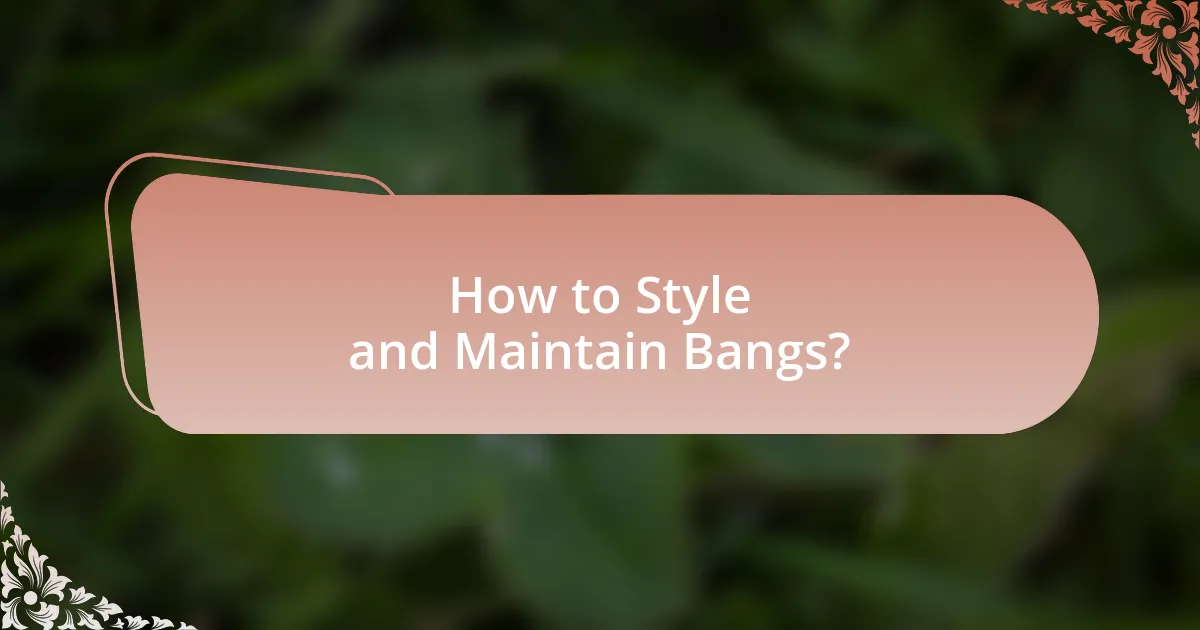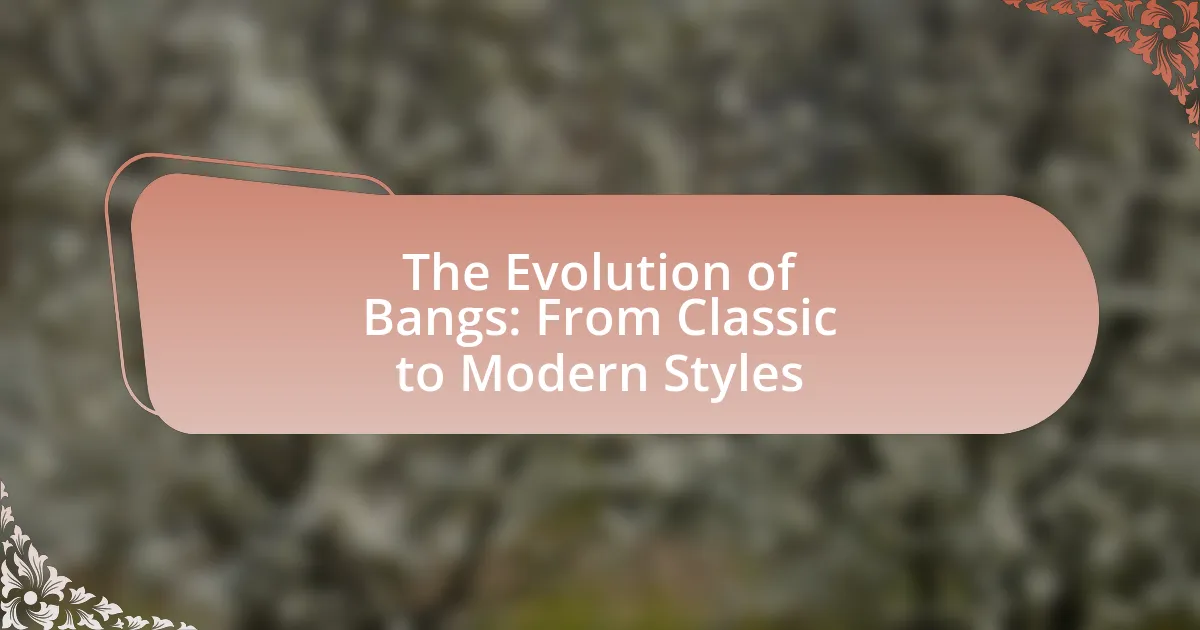The article explores the evolution of bangs, a hairstyle defined by hair cut straight across the forehead, and their historical significance across various cultures. It details the changing styles of bangs from the 1920s to the present, highlighting their role in symbolizing youth, rebellion, and femininity. The piece examines different types of bangs, their characteristics, and how factors such as face shape and hair texture influence their selection. Additionally, it provides insights into styling and maintaining bangs, common mistakes to avoid, and tips for transitioning to or growing out bangs, emphasizing their timeless appeal and adaptability in modern fashion.

What are Bangs and Their Historical Significance?
Bangs are a hairstyle characterized by hair cut straight across the forehead, often framing the face. Historically, bangs have been significant in various cultures, symbolizing youth and rebellion, particularly during the 1920s flapper era when women sought to break free from traditional norms. The popularity of bangs has fluctuated over time, with notable revivals in the 1960s and 1970s, reflecting changing societal attitudes towards femininity and fashion. Their enduring presence in modern styles underscores their role as a versatile and expressive element in hairstyling.
How have bangs evolved throughout different eras?
Bangs have evolved significantly from the 1920s to the present, reflecting cultural shifts and fashion trends. In the 1920s, the bob haircut popularized blunt bangs, symbolizing women’s liberation and modernity. The 1960s introduced softer, side-swept bangs, influenced by icons like Brigitte Bardot, which conveyed a more romantic and youthful aesthetic. The 1980s saw the rise of voluminous, teased bangs, aligning with the bold fashion of the era. In the 2000s, bangs became more versatile, with styles ranging from choppy to curtain bangs, catering to diverse preferences. Today, bangs continue to adapt, with trends emphasizing natural textures and personalized styles, showcasing their enduring appeal across generations.
What were the defining styles of bangs in the 1920s?
The defining styles of bangs in the 1920s included blunt cuts, side-swept bangs, and wispy fringes. Blunt bangs, often cut straight across the forehead, became iconic with the flapper look, symbolizing the era’s shift towards modern femininity. Side-swept bangs offered a softer alternative, frequently styled with waves or curls, complementing the bobbed hairstyles popularized by celebrities like Louise Brooks. Wispy fringes, characterized by their light and airy appearance, added a playful touch to various hairstyles, reflecting the youthful spirit of the decade. These styles collectively represented the bold fashion choices of the 1920s, marking a departure from previous, more conservative hair trends.
How did the 1960s influence modern bang styles?
The 1960s significantly influenced modern bang styles by popularizing bold, geometric cuts and the iconic fringe seen in the hairstyles of figures like Brigitte Bardot and the Beatles. This era introduced bangs as a statement of youth culture and rebellion, leading to variations such as blunt cuts and side-swept styles that are prevalent today. The cultural shift towards individual expression and experimentation in the 1960s laid the groundwork for the diverse interpretations of bangs in contemporary hairstyling, making them a versatile choice for various face shapes and personal styles.
Why are bangs considered a timeless hairstyle?
Bangs are considered a timeless hairstyle because they have consistently adapted to various fashion trends while remaining popular across different eras. This versatility allows bangs to complement a wide range of face shapes and hair types, making them a go-to choice for many individuals. Historical evidence shows that bangs have been worn since ancient civilizations, such as in Ancient Egypt, where they were a symbol of status and beauty. Additionally, their resurgence in popularity during the 1920s with flapper styles and their continued presence in modern fashion illustrate their enduring appeal.
What cultural factors contribute to the popularity of bangs?
Bangs are popular due to their association with various cultural movements and iconic figures throughout history. The influence of celebrities, such as Audrey Hepburn in the 1950s and more recently, figures like Zooey Deschanel, has made bangs a fashionable choice, symbolizing youth and modernity. Additionally, bangs often reflect cultural shifts towards individuality and self-expression, as seen in the punk and grunge movements of the 1970s and 1990s, respectively. The versatility of bangs allows them to be adapted across different styles and demographics, further enhancing their appeal in diverse cultural contexts.
How do bangs reflect personal identity and fashion trends?
Bangs serve as a significant expression of personal identity and are closely tied to fashion trends. They allow individuals to showcase their personality, with styles ranging from blunt cuts to wispy layers, reflecting various cultural and social influences. Historically, bangs have been associated with different movements; for example, the 1920s flapper style embraced short, straight bangs as a symbol of modernity and liberation. In contemporary fashion, celebrities and influencers often popularize specific bang styles, influencing public perception and adoption. This cyclical nature of bangs in fashion demonstrates their role in both personal expression and broader societal trends, as seen in the resurgence of curtain bangs in recent years, which align with a nostalgic return to 90s aesthetics.

What are the Different Types of Bangs?
The different types of bangs include blunt bangs, side-swept bangs, curtain bangs, wispy bangs, and choppy bangs. Blunt bangs are cut straight across the forehead, providing a bold look. Side-swept bangs are longer and styled to one side, offering a softer appearance. Curtain bangs frame the face and blend into longer hair, creating a versatile style. Wispy bangs are light and feathery, adding texture without overwhelming the face. Choppy bangs feature uneven lengths for a more edgy look. Each type of bang serves to enhance facial features and can be adapted to various hair types and styles.
How do various bang styles differ from one another?
Various bang styles differ primarily in their length, shape, and texture. For example, blunt bangs are cut straight across the forehead, creating a bold and defined look, while side-swept bangs are longer and angled, offering a softer appearance. Curtain bangs, which are parted in the middle and frame the face, contrast with choppy bangs that have uneven lengths for a more textured effect. Additionally, wispy bangs are light and airy, differing from heavy, thick bangs that provide a more dramatic statement. Each style serves different aesthetic purposes and complements various face shapes and hairstyles, showcasing the versatility of bangs in hair fashion.
What are the characteristics of blunt bangs?
Blunt bangs are characterized by their straight, even cut across the forehead, creating a bold and defined look. This style typically features a uniform length without layering, which enhances the sharpness of the fringe. Blunt bangs can frame the face effectively, drawing attention to the eyes and cheekbones. They are versatile, complementing various face shapes and hairstyles, and are often associated with a modern, chic aesthetic. The popularity of blunt bangs has been reinforced by numerous celebrities and fashion icons, making them a timeless choice in hair fashion.
How do side-swept bangs enhance facial features?
Side-swept bangs enhance facial features by framing the face and drawing attention to the eyes and cheekbones. This hairstyle creates an asymmetrical look that softens angular features and adds dimension, making the overall appearance more balanced. Research indicates that hairstyles that frame the face can significantly influence perceptions of attractiveness, as they highlight key facial attributes. For instance, a study published in the Journal of Cosmetic Dermatology found that hairstyles that accentuate facial contours can improve perceived facial symmetry, which is often associated with beauty.
What factors should be considered when choosing a bang style?
When choosing a bang style, factors such as face shape, hair texture, maintenance level, and personal style should be considered. Face shape influences how bangs frame the features; for example, oval faces can pull off most styles, while round faces may benefit from longer, side-swept bangs. Hair texture affects how bangs lay and style; fine hair may require lighter bangs, while thick hair can support heavier styles. Maintenance level is crucial, as some bangs require regular trims and styling, while others may be more low-maintenance. Lastly, personal style should align with the chosen bang style to ensure it complements the overall look.
How does face shape influence the choice of bangs?
Face shape significantly influences the choice of bangs by determining which styles complement or balance facial features. For example, individuals with round faces often benefit from long, side-swept bangs that elongate the appearance of their face, while those with square faces may prefer soft, wispy bangs that soften angular features. Research indicates that selecting bangs that align with face shape can enhance overall facial symmetry and aesthetics, making the choice of bangs a crucial aspect of hairstyling.
What hair texture considerations are important for bangs?
Hair texture significantly influences the suitability and styling of bangs. For instance, fine hair may require lighter, wispy bangs to avoid looking flat, while thick hair benefits from blunt cuts that can hold their shape. Curly hair often necessitates longer bangs to prevent shrinkage, whereas straight hair can accommodate various lengths and styles. Additionally, the texture affects how bangs blend with the rest of the hairstyle, impacting overall volume and movement. Understanding these considerations ensures that bangs complement the individual’s hair type effectively.

How to Style and Maintain Bangs?
To style and maintain bangs, regularly trim them every 4 to 6 weeks to keep the length manageable and prevent split ends. Use a round brush while blow-drying to create volume and shape, and apply a lightweight styling product to hold the bangs in place without weighing them down. Additionally, using a flat iron can help achieve a sleek look, while a texturizing spray can add dimension. Proper maintenance includes washing bangs frequently to prevent oil buildup, as they can become greasy faster than the rest of the hair. Regularly using a heat protectant is essential to minimize damage from styling tools.
What are the best techniques for styling bangs?
The best techniques for styling bangs include blow-drying with a round brush, using a flat iron for sleekness, and employing texturizing products for a more casual look. Blow-drying with a round brush helps create volume and shape, allowing bangs to frame the face effectively. Flat irons can be used to achieve a polished, straight appearance, which is ideal for blunt bangs. Additionally, texturizing products like mousse or sea salt spray can add movement and a relaxed vibe to softer, wispy bangs. These methods are widely recognized in hairstyling practices, ensuring versatility and adaptability to various hair types and styles.
How can heat tools be used effectively on bangs?
Heat tools can be used effectively on bangs by ensuring the right temperature and technique are applied to achieve the desired style without causing damage. For instance, using a flat iron or curling wand at a moderate heat setting (around 300-350°F) helps to create smooth, polished bangs or soft waves while minimizing heat damage. Additionally, sectioning the bangs into smaller parts allows for more precise styling, ensuring even heat distribution and better control. Using a heat protectant spray before applying heat is crucial, as it can reduce the risk of damage by forming a barrier against high temperatures. Studies show that proper heat application and protection can significantly extend the lifespan of hairstyles while maintaining hair health.
What products are recommended for maintaining bangs?
To maintain bangs effectively, recommended products include a lightweight styling cream, a heat protectant spray, and a flexible-hold hairspray. A lightweight styling cream helps to control frizz and define the shape of the bangs without weighing them down. A heat protectant spray is essential when using heat styling tools, as it prevents damage and maintains the integrity of the hair. Finally, a flexible-hold hairspray provides hold while allowing movement, ensuring that bangs stay in place throughout the day without becoming stiff. These products are widely endorsed by hairstylists for their effectiveness in keeping bangs looking fresh and styled.
What common mistakes should be avoided when styling bangs?
Common mistakes to avoid when styling bangs include cutting them too short, neglecting face shape, and using the wrong styling products. Cutting bangs too short can lead to an unflattering look, as they may not blend well with the rest of the hairstyle. Neglecting to consider face shape can result in bangs that do not enhance facial features; for example, blunt bangs may not suit a round face. Using the wrong styling products can weigh down bangs or make them appear greasy, which detracts from the overall style. These mistakes can significantly impact the effectiveness of bangs in complementing a hairstyle.
How can one prevent bangs from becoming greasy or flat?
To prevent bangs from becoming greasy or flat, regularly wash them with a mild shampoo and use dry shampoo between washes to absorb excess oil. Bangs are prone to oiliness due to their proximity to the forehead, where natural oils accumulate. Using a lightweight styling product can also help maintain volume without weighing them down. Studies indicate that hair products containing ingredients like silica can enhance volume and texture, making bangs appear fuller and less greasy.
What are some tips for transitioning to bangs?
To transition to bangs successfully, start by choosing a style that complements your face shape and hair texture. Consulting with a professional stylist can provide personalized recommendations based on these factors. Gradually introducing bangs, such as opting for curtain bangs or side-swept bangs, allows for an easier adjustment period. Additionally, using styling products like a lightweight mousse or texturizing spray can help manage the new look. Research indicates that gradual changes can reduce the stress of a dramatic haircut, making the transition smoother for individuals.
How can one prepare for the commitment of bangs?
To prepare for the commitment of bangs, one should first assess their face shape and hair type to determine the most flattering bang style. Research indicates that different face shapes suit specific bang styles; for example, round faces often benefit from side-swept bangs, while square faces may look better with soft, wispy bangs. Additionally, consulting with a professional hairstylist can provide personalized recommendations based on individual features and hair texture. This preparation ensures that the chosen bangs enhance one’s overall appearance and align with personal style preferences.
What are the best ways to grow out bangs if desired?
To grow out bangs effectively, regularly trim the ends to maintain healthy hair while allowing the bangs to blend with the rest of the hair. This method prevents split ends and promotes overall hair health, which is essential for growth. Additionally, using hair growth products containing biotin or essential oils can stimulate hair follicles, enhancing growth rates. Studies indicate that biotin supplementation can improve hair thickness and growth, making it a beneficial choice for those looking to grow out bangs. Maintaining a balanced diet rich in vitamins and minerals also supports hair health, further aiding in the growth process.


